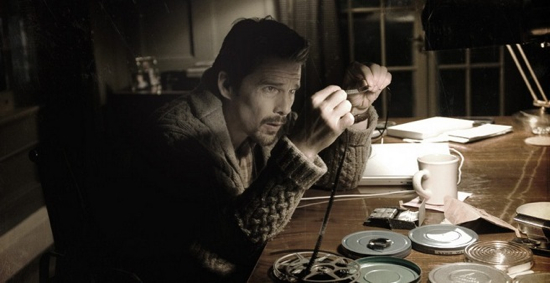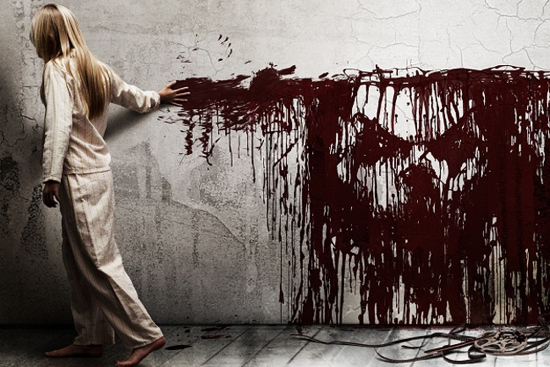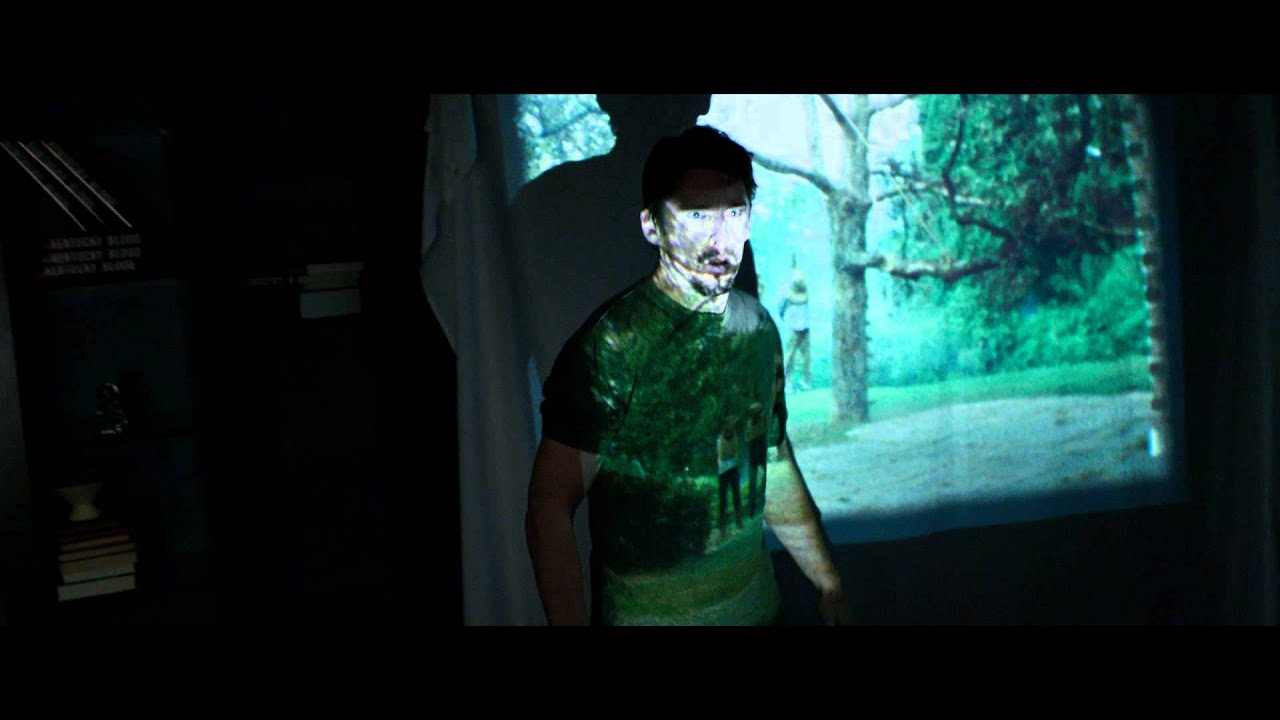At FrightFest 2012 one of the real scare-a-thons was a good ol’ fashioned ghost story: Sinister. The day after its UK premiere, shamed hardcore horror fans could be heard swapping stories in the foyer of the Leicester Square Empire about how they finally managed to get to sleep, as their nighttime imaginations ran wild with memories of what they’d seen. Myself, I watched three episodes of It’s Always Sunny In Philadelphia, until at least a little light poked through my curtains, before nodding off.
Sinister is the story of a self-righteous true crime writer, Ellison (Ethan Hawke) who constantly uproots his family so he can be closer to the unsolved murder he intends to investigate – usually at the expense of the local police force’s reputation. What he neglects to tell his British wife, Tracy (Juliet Rylance), and two troubled children is that their new home is the venue where the horrific family murder and missing child he is researching took place. The local sheriff (Fred Dalton Thompson) who doesn’t care too much for Ellison’s methods is their welcome party, and he suggests they pack up, turn around and go back to where they came from. Ellison locks horns with him and explains that humiliating the police is fair game if they don’t do their job properly.
The discovery of a Super 8 camera and reels of film in the attic provide evidence of more brutal murders, with the motif of a ghoulish figure lurking in each one. As Ellison pieces it all together – thanks in no small part to the diligence of a true crime fanboy deputy (James Ransone) – the supernatural and unreal become an endless nightmare that his family may not be able to escape.
Ain’t It Cool News critic turned screenwriter Christopher Robert Cargill wrote Sinister with director Scott Derrickson (best known for 2005’s The Exorcism Of Emily Rose). It is Cargill’s debut feature and the Quietus was keen to hear how this poacher turned gamekeeper coped with his own expectations of a good movie – and how the hell he came up with such a scary one…
What influence did being a film critic for so long have on you when you sat down to write your own script?
C Robert Cargill: I think I always knew I wanted to write fiction. It’s something I’ve done since I was eight years old. I’ve spent a decade of my life learning what stories audiences wanted to see and how they wanted to see them. So when I sat down to write I knew not only how the audience would react, but also how the critics would react. We knew the critics were going to bump us a bit by saying we weren’t that original, that it’s a haunted house movie – which it is by design. The entire film is assembled in a way that feels familiar, but all the elements are new.
The local sheriff’s opening argument with the indignant Ellison is the most subtle harbinger of doom I’ve seen in a long time.
CRC: Most of that speech was written in the pitch for Sinister. I knew I had to introduce our character in a way that the people reading the treatment would fully understand who Ellison was. Most of that speech came, verbatim, from the very first thing I wrote. When we put it in the script I wrote it as a Fred Dalton Thompson character. [Scott Derrickson and I] were told we wouldn’t be able to get him because he’s very choosy about his scripts and such. But we sent him it anyway and sure enough we got a call to say FDT read the script, likes it very much and really wants to do it. So I got to make a FDT movie, which made me very happy.
That sequence was always important to us. We really do establish who Ellison is in the opening of the movie and we establish what is going to happen. But the audience thinks they’re watching two guys bust balls. The entire sequence is pure exposition, but each guy is giving it in a manner that the audience buys… and it worked. So we’re happy that it worked out because people seem to react the way you did – when you go back and reflect upon it there’s a lot of important information in that sequence.
Like all horror, the use of sudden sound and lots of shadow really made Sinister scary.
CRC: For me horror goes back to Val Lewton’s Cat People [1942, directed by Jacques Tourneur]. They did the make-up for all these creatures and then when they saw it they thought it was terrible and the audience will laugh. Lewton just said we’ll shoot it with shadow and hopefully that will work. It ended up being one of the most terrifying horrors of the time because everyone had something different in their head, and what was in their head was what terrified them. That’s why haunted house movies work and why ghosts scare us. Technically speaking, ghosts are pretty harmless. They run around, thump things, make noise, slam doors and maybe they throw stuff at you. But a ghost isn’t really going to tear you apart and disembowel you. So why do they scare us so much? Well, it’s the fact that it’s unknown. We don’t know what they are. We don’t know what they want to do. A lot of the time we can’t even see them. That whole notion makes them scarier than a guy stood in front of us with an axe.
In Sinister, sound and shadow obscures enough and gives us the hint that there’s some kind of danger, but we don’t know what it is and it freaks us out. I think really great horror stems from great cinematography and great sound design built around a great idea. A good example is The House Of The Devil [2009, Ti West]. For 75 minutes it’s just a girl walking around a dark house and that’s really creepy. And all it is, is shadow and sound.
What’s your benchmark horror movie?
CRC: The film I drew the most from is The Changeling [1980, Peter Medak]. It was a big inspiration. It’s about a guy whose family have died and how he deals with that, as he starts encountering the ghost of a little boy who he believes is the ghost of his son. So, it’s one man going through his personal shit while simultaneously wrestling with this supernatural force and trying to find a resolution through that… George C Scott is just amazing.
I love him in Hardcore [1979, Paul Schrader].
CRC: Oddly enough Hardcore was an influence on Sinister as well. You know the scene where George C Scott is watching the [8mm stag] film of his daughter? When we were talking about how to shoot Sinister I brought up Hardcore. We need to be watching Ellison and we need to see his reaction [to the film] and the audience getting freaked out by that, rather than us throwing gory visceral stuff at the screen, because that’s what is going to destroy the audience. So we borrowed very heavily from Hardcore.

How did you come up with supernatural bad guy Mr Boogie?
CRC: It was really just a case of sitting down and poring over books about folklore, and culling different pieces here and there that I found interesting. Just finding those nuggets mentioned in the histories of deities and demons. I played with it for a while until I found Mr Boogie. It was research for inspiration until all the pieces were apparent, and then putting them together into something that was significantly scary.
I wrote a book called Dreams And Shadows [to be published February 2013 in the UK] and that’s one of the ideas I play around with. I actually address the very notion in a section of the book. We have these stories and they change from region to region, and yet they all have stuff in common. Every major culture in the world has a vampire myth. Creatures that go out at night and suck blood from the living. Even Aboriginals in Australia have one. Vampiric creatures that are mostly bones and when the wind blows, it whistles through them. They suck out not just the blood, but the blood and meat of a person. They do it until there’s nothing left but a desiccated corpse, and then you turn into one of them. It’s very interesting that these ideas permeate different cultures. This works in your favour as a storyteller because it’s easy to find the common threads that bind them together, and see how to put a creature together and make it genuinely terrifying to somebody. That’s what I tried to do with Mr Boogie.
What influence does black metal stage make-up have on the look of Mr Boogie?
CRC: There really wasn’t any. It’s kind of weird, though, because black metal does have its place on the soundtrack, but that isn’t where we got the design of our ghoul from. Originally, I imagined he was an undead, twisted Willy Wonka. My original had a ratty top hat and tails. Scott [Derrickson] looked through Flickr and he found this amazing image of a face and I said that’s Mr Boogie. We paid $5000 to the artist and now he’s the guy who drew the bogeyman [for Sinister].
Sinister‘s screening at FrightFest was your UK premiere and the audience response bettered your expectations.
CRC: That audience is just killer. Watching that there was maybe my favourite experience of watching it – even trumps the experience of watching it at SXSW with an audience full of people I’ve been watching films with for years. [FrightFest] is a bunch of film lovers watching horror movies. It’s much more limited in scope compared to say Fantastic Fest [the largest genre film festival in the US, specializing in horror, fantasy, sci-fi and action]. At the same time you have a British audience that appreciates dry humour more than Americans do. There’s a lot of stuff in Sinister that we intended. Showing it to a British audience, they laughed out loud. It was a really interesting experience to watch the appreciation of the very subtle humour at a much more visceral level than we’ve got from any of our US screenings. And seeing that in a 1300 seat theatre… It was amazing.
Sinister goes on nationwide theatrical release from Friday October 5.



